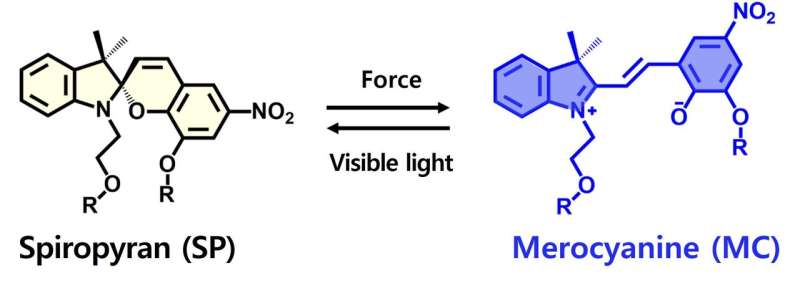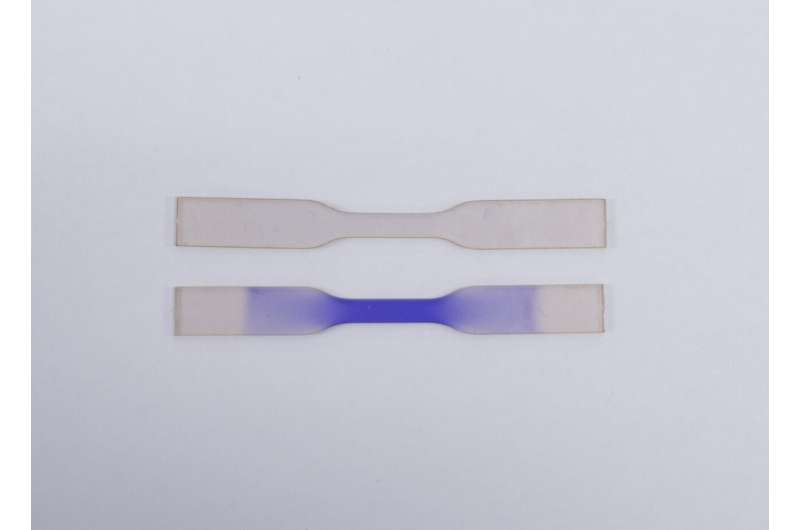Chemical structure of the spiropyran (SP) mechanophore and its transformation into the merocyanine (MC) form. Credit: Korea Institue of Science and Technology(KIST)
Human skin bruises when the tissue and muscle in the area suffer trauma or become damaged due to the application of blunt force. However, when an object suffers an impact, it is necessary to examine every inch of the surface of the material to understand the extent of the damage. An airplane, for example, it is fully inspected to ensure safety. If the areas damaged by a physical impact undergo a change in color, just like human skin, it will be easy to distinguish what needs to be repaired.
Spiropyran, a molecule that reacts to external force, changes color when it is physically stimulated due to a change in its chemical structure. When injected into concrete or silicone, it reacts to mechanical stimuli such as force, deformation and damage by changing color. However, the mechano-sensitivity of spiropyran is too low for real-life applications. When applied to silicone, for example, the color changes only after deformation of at least 500%.
A research team headed by Dr. Jaewoo Kim from the Structural Composite Research Center at the Institute of Advanced Composite Materials of the Korea Institute of Science and Technology (KIST) has drastically improved the mechano-sensitivity for the material to be applicable to wearable sensors and artificial skin.
In order to enhance sensitivity of spiropyran, previous studies have modified its molecular structure according to the material it would be combined with prior to synthesis. In contrast, the KIST researchers synthesized the composite material first and then added a certain type of solvent to improve the sensitivity through a sort of aging process. Then the changes in the color and fluorescence of the composite material were observed, while controlling the absorption time with the solvent, and it was found that increasing the treatment time improved the sensitivity. The spiropyran polymer developed through this new process showed 850% improvement in sensitivity compared to previously developed materials. This remarkable sensitivity was seen for various types of deformations such as tension, compression and bending.
A picture of mechano-sensitive material to be applicable to wearable sensors and artificial skin. Credit: Korea Institue of Science and Technology(KIST)
Also, unlike the existing method of improving sensitivity by manipulating each material separately, the new method developed through this study that increases sensitivity simply with an aging process using a solvent presents advantages in that it can be easily applied to various materials.
Dr. Jaewoo Kim from KIST said: "Through this study, a process that can dramatically improve the mechano-sensitivity of spiropyran-based, stress-sensitive smart polymer materials has been developed, and through analysis, the mechanism behind sensitivity improvement was identified. [...] Based on this, we plan to devote ourselves to a follow-up study in which we apply the technology to futuristic wearable sensors and artificial skin."
More information: Dong Woo Kim et al, Enhancement of Mechano-Sensitivity for Spiropyran-Linked Poly(dimethylsiloxane) via Solvent Swelling, Macromolecules (2020). DOI: 10.1021/acs.macromol.0c00985
Provided by National Research Council of Science & Technology

























